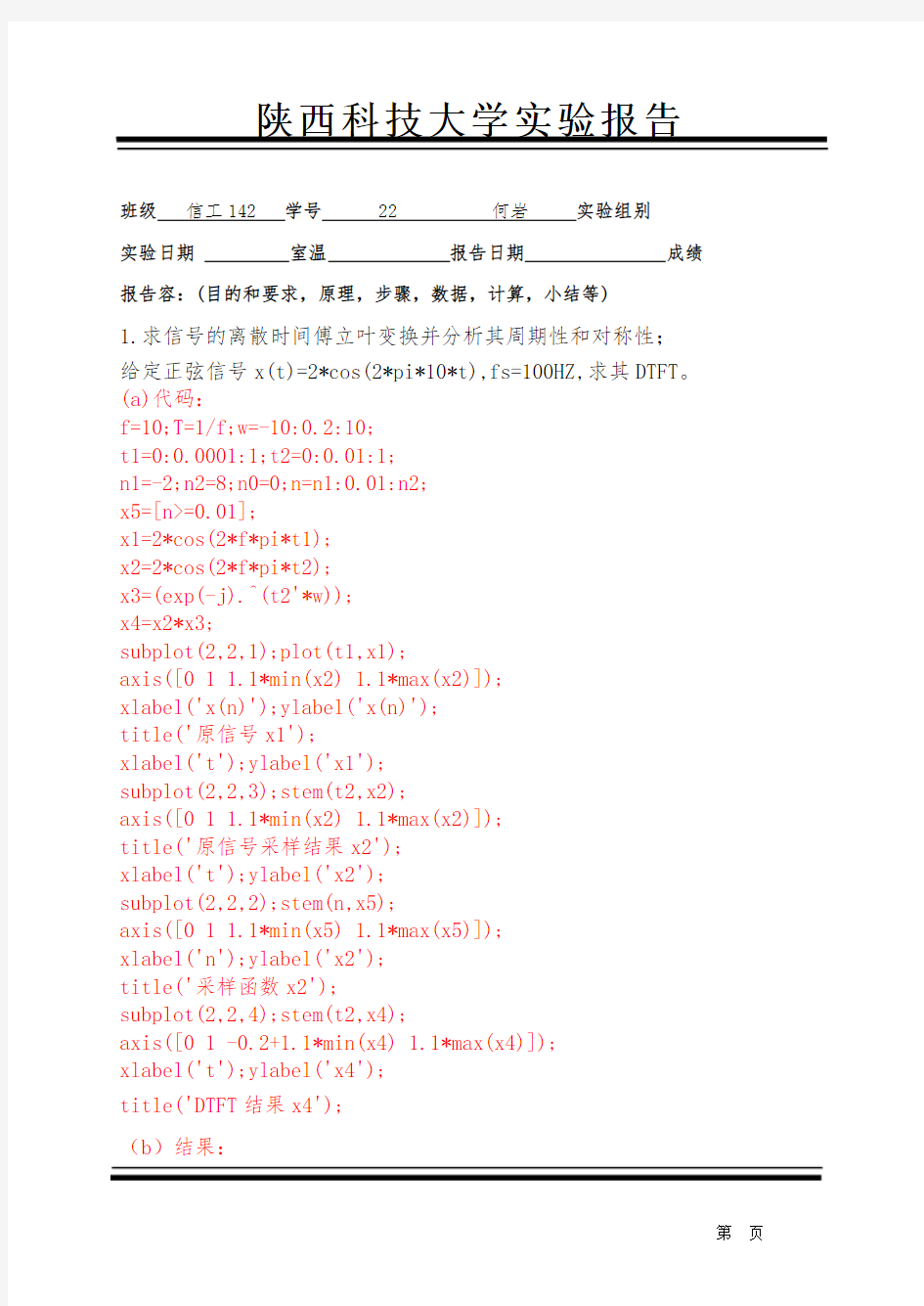
MAtlab-傅里叶变换-实验报告
- 格式:doc
- 大小:397.50 KB
- 文档页数:12


陕西科技大学实验报告
班级信工142 学号 22 何岩实验组别
实验日期室温报告日期成绩报告容:(目的和要求,原理,步骤,数据,计算,小结等)
1.求信号的离散时间傅立叶变换并分析其周期性和对称性;
给定正弦信号x(t)=2*cos(2*pi*10*t),fs=100HZ,求其DTFT。
(a)代码:
f=10;T=1/f;w=-10:0.2:10;
t1=0:0.0001:1;t2=0:0.01:1;
n1=-2;n2=8;n0=0;n=n1:0.01:n2;
x5=[n>=0.01];
x1=2*cos(2*f*pi*t1);
x2=2*cos(2*f*pi*t2);
x3=(exp(-j).^(t2'*w));
x4=x2*x3;
subplot(2,2,1);plot(t1,x1);
axis([0 1 1.1*min(x2) 1.1*max(x2)]);
xlabel('x(n)');ylabel('x(n)');
title('原信号x1');
xlabel('t');ylabel('x1');
subplot(2,2,3);stem(t2,x2);
axis([0 1 1.1*min(x2) 1.1*max(x2)]);
title('原信号采样结果x2');
xlabel('t');ylabel('x2');
subplot(2,2,2);stem(n,x5);
axis([0 1 1.1*min(x5) 1.1*max(x5)]);
xlabel('n');ylabel('x2');
title('采样函数x2');
subplot(2,2,4);stem(t2,x4);
axis([0 1 -0.2+1.1*min(x4) 1.1*max(x4)]);
xlabel('t');ylabel('x4');
title('DTFT结果x4');
(b)结果:
2.用以下两个有限长序列来验证DTFT的线性、卷积和共轭特性;
(n)
x1(n)=[1 2 3 4 5 6 7 8 9 10 11 12];x2(n)=R
10
(1)线性:(a)代码:
w=linspace(-8,8,10000);
nx1=[0:11]; nx2=[0:9];
x1=[1 2 3 4 5 6 7 8 9 10 11 12];
x2=[1 1 1 1 1 1 1 1 1 1];
x3=[x2,zeros(1,(length(x1)-length(x2)))];
x4=2*x1+3*x3;
X1=x1*exp(-j*nx1'*w);%频率特性
X3=x3*exp(-j*nx1'*w);%频率特性
X4=x4*exp(-j*nx1'*w);%频率特性
subplot(5,3,1),stem(nx1,x1),axis([-1,13,0,15]);title('x1'), ylabel('x(n)');
subplot(5,3,2),stem(nx2,x2),axis([-1,13,0,5]);title('x2'); subplot(5,3,3),stem(nx1,x4),axis([-1,13,0,26]);title('x4=2*x1+3*x 3');
subplot(5,3,4),plot(w,abs(X1)); ylabel('幅度')
subplot(5,3,7),plot(w,angle(X1));ylabel('相位')
subplot(5,3,10),plot(w,real(X1));ylabel('实部')
subplot(5,3,13),plot(w,imag(X1)); ylabel('虚部')
subplot(5,3,5),plot(w,abs(X3));
subplot(5,3,8),plot(w,angle(X3));
subplot(5,3,11),plot(w,real(X3));
subplot(5,3,14),plot(w,imag(X3));
subplot(5,3,6),plot(w,abs(X4));
subplot(5,3,9),plot(w,angle(X4));
subplot(5,3,12),plot(w,real(X4));
subplot(5,3,15),plot(w,imag(X4));
(b)结果:
(2)卷积:(a)代码:
nx1=0:11; nx2=0:9; nx3=0:20;
w=linspace(-8,8,40); %w=[-8,8]分10000份
x1=[1 2 3 4 5 6 7 8 9 10 11 12];
x2=[1 1 1 1 1 1 1 1 1 1];
x3=conv(x1,x2);% x1卷积x2
x4=x1*exp(-j*nx1'*w);% x1频率特性
x5=x2*exp(-j*nx2'*w);% x2频率特性
x6=x3*exp(-j*nx3'*w);% x1卷积x2频率特性
x7=x4.*x5;
subplot(2,2,1),stem(nx1,x1),axis([-1,15,0,15]),title('x1'); subplot(2,2,2),stem(nx2,x2),axis([-1,15,0,5]),title('x2'); subplot(2,1,2),stem(nx3,x3),axis([-1,25,0,80]);title('x1卷积x2结